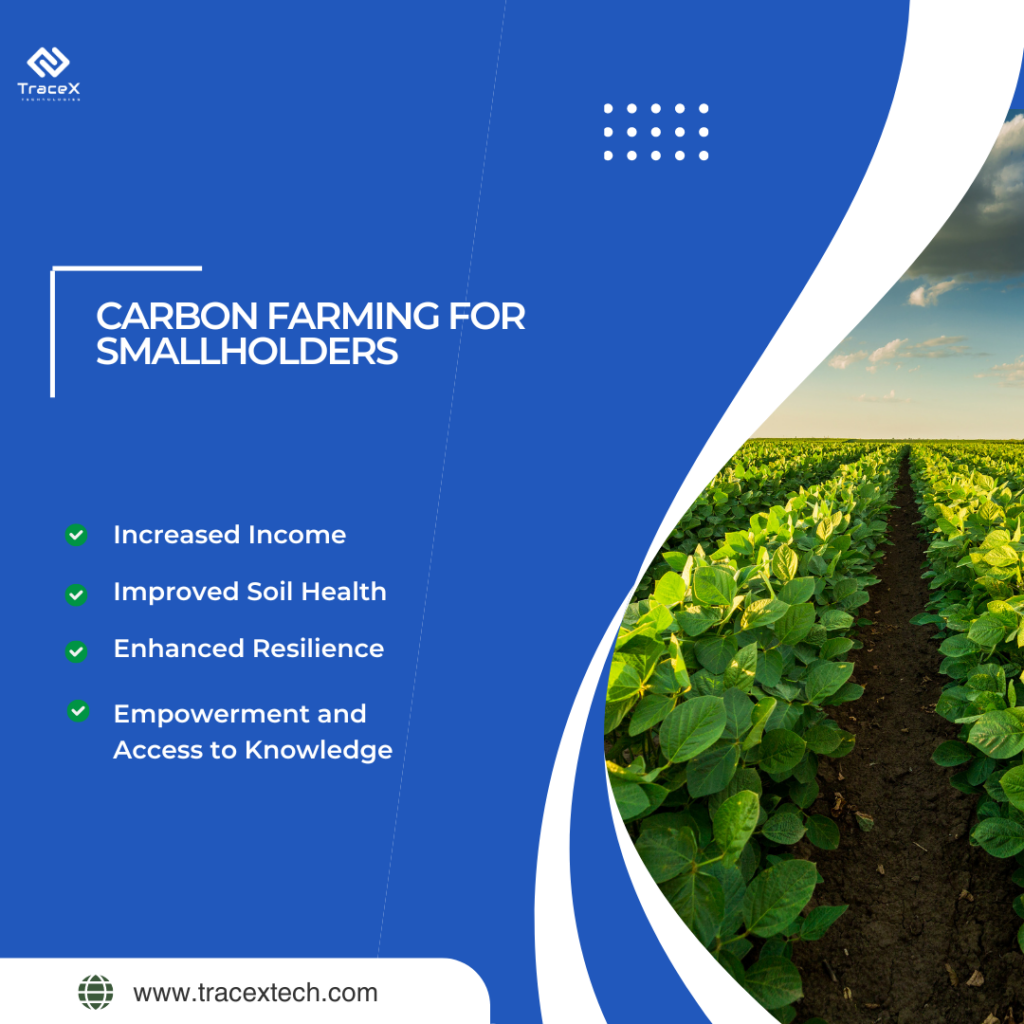Contact: +91 99725 24322 |
Menu
Menu
Quick summary: Discover how carbon farming is revolutionizing agriculture's response to climate change. Explore innovative practices, success stories, and the transformative potential of integrating carbon farming into agricultural systems. Join the movement towards a more sustainable future.

In the face of escalating climate change, agriculture stands at a pivotal crossroads. As the sector responsible for both feeding the world’s population and contributing to greenhouse gas emissions, it must undergo a transformative shift to mitigate its environmental impact. Enter carbon farming, a groundbreaking approach that holds the potential to revolutionize agriculture’s role in combating climate change.
Carbon farming is more than just a buzzword; it’s a multifaceted strategy that harnesses the power of agricultural practices to sequester carbon dioxide from the atmosphere and store it in soil and vegetation. By integrating innovative techniques such as agroforestry, rotational grazing, cover cropping, and no-till farming, carbon farming not only reduces carbon emissions but also enhances soil health, increases biodiversity, and promotes resilience to extreme weather events.
While agriculture contributes to the problem, it can also be part of the solution. Agricultural production currently accounts for 11% of global greenhouse gas emissions, with the largest share coming from the livestock sector.
Carbon farming is a set of agricultural practices designed to capture atmospheric carbon dioxide (CO2) and store it in the soil and plant biomass. This approach aims to mitigate climate change by offsetting carbon emissions from other sectors.
S&P Global study estimates that food and beverage sector accounts for 57% of total potential demand for carbon credits in agricultural lands and based on all sectors examined, internal company prices currently range from $5 to $60/tCO2e.
The concept of soil organic matter influencing fertility has been understood for centuries. Scientific advancements in soil science and climate change have led to a renewed focus on carbon sequestration in agriculture. Concerns about climate change and the potential for carbon farming to generate carbon credits have driven increased interest in recent years.
Conventional agriculture prioritizes crop production and yield maximization. Carbon farming integrates carbon sequestration as a key objective alongside productivity. Conventional agriculture often relies on intensive tillage practices that release stored soil carbon. Carbon farming emphasizes minimizing soil disturbance and promoting organic matter build-up. Conventional agriculture often relies on chemical fertilizers and pesticides. Carbon farming emphasizes building healthy soil ecosystems that reduce dependence on these inputs. Conventional agriculture often focuses on short-term production goals. Carbon farming adopts a long-term perspective, considering the impact of practices on soil health and carbon storage.
In essence, carbon farming goes beyond just producing food. It actively contributes to mitigating climate change by drawing down carbon dioxide from the atmosphere and storing it in the form of soil organic matter and plant biomass.

Carbon farming offers a compelling solution for mitigating climate change while simultaneously enhancing agricultural practices.
Carbon Sequestration and Mitigation: Carbon farming practices act as natural carbon sinks. By promoting soil organic matter accumulation and plant growth, carbon dioxide is removed from the atmosphere and stored in the soil and plant biomass. This reduces the overall atmospheric CO2 concentration, mitigating climate change impacts.
Soil Health and Fertility Improvement: Carbon farming practices like cover cropping and no-till farming promote the growth of beneficial soil microbes and increase organic matter content. This leads to improved soil structure, water retention capacity, and nutrient availability, ultimately enhancing soil fertility.
Reduced Reliance on Chemical Inputs: Healthy, fertile soil fosters natural pest and disease resistance in plants. This can potentially reduce the need for chemical fertilizers and pesticides, promoting a more sustainable agricultural system.
Biodiversity Conservation and Habitat Restoration: Practices like agroforestry create habitats for various insects, birds, and small animals. Additionally, reduced tillage and cover cropping promote a diverse range of soil organisms, fostering a healthy and balanced ecosystem within the agricultural landscape.
Pollinator Support: Increased plant diversity through cover cropping and hedgerows attracts pollinators like bees and butterflies, crucial for ensuring plant reproduction and healthy ecosystems.
Resilience to Climate Change Impacts: Improved soil health with higher organic matter content leads to better water retention capacity. This makes crops more resilient to drought conditions, a growing concern in many regions due to climate change.
Reduced Erosion Risk: Cover crops and practices that minimize soil disturbance protect the soil surface from wind and water erosion. This is crucial for maintaining soil health and productivity in the face of extreme weather events.
Economic Incentives and Co-benefits for Farmers: Carbon farming practices can generate carbon credits that farmers can sell to companies or organizations seeking to offset their carbon footprint. This creates a new revenue stream for farmers who adopt sustainable practices.
Improved Production Efficiency: Healthy soil with increased organic matter content can lead to higher crop yields and improved overall farm productivity. This translates to increased economic returns for farmers.
In conclusion, carbon farming offers a win-win situation for both the environment and farmers. By sequestering carbon, improving soil health, promoting biodiversity, and enhancing climate resilience, carbon farming paves the way for a more sustainable and climate-friendly agricultural future.
While carbon farming offers a promising approach to climate change mitigation and improved agricultural practices, there are several challenges that need to be addressed for wider adoption:
In the world of carbon farming, Measurement, Reporting, and Verification (MRV) play a critical role in establishing trust and unlocking the full potential of this climate-friendly practice.
1. Accurate Carbon Sequestration Measurement:
2. Enhanced Transparency and Credibility:
3. Building Trust with Stakeholders:
4. Promoting Continuous Improvement:
VNV, a leading carbon project developer was able to promote sustainable rice cultivation practices with a focus on carbon sequestration. To track the effectiveness of their strategy and ensure transparency, they turned to TraceX’s innovative DMRV (Measurement, Reporting, and Verification) platform. Here’s how TraceX empowered VNV’s use of Alternate Wetting and Drying (AWD) techniques for carbon-conscious rice farming:
Transparency Throughout the Value Chain: TraceX’s platform provided a transparent system for stakeholders to understand VNV’s commitment to sustainable agriculture. Investors, consumers, and other interested parties could access data and reports on VNV’s AWD practices and their verified carbon sequestration impact.
In conclusion, VNV’s collaboration with TraceX demonstrates the power of technology in promoting sustainable agriculture. By leveraging the DMRV platform, VNV gained valuable insights into the carbon-sequestering potential of AWD techniques, ensured the credibility of their efforts, and paved the way for a more sustainable future for rice cultivation.
By harnessing the power of nature and innovative practices, farmers can play a pivotal role in mitigating climate change while simultaneously enhancing the sustainability and productivity of their operations. As we’ve explored throughout this blog, carbon farming offers a multifaceted solution that not only sequesters carbon dioxide but also revitalizes soil health, preserves biodiversity, and fortifies against the impacts of extreme weather events. Embracing carbon farming isn’t just an option; it’s a necessity in our collective efforts to secure a more resilient and regenerative future for generations to come. Let us heed the call to action, rally behind sustainable agricultural practices, and sow the seeds of change through carbon farming. Together, we can cultivate a healthier planet for all.
